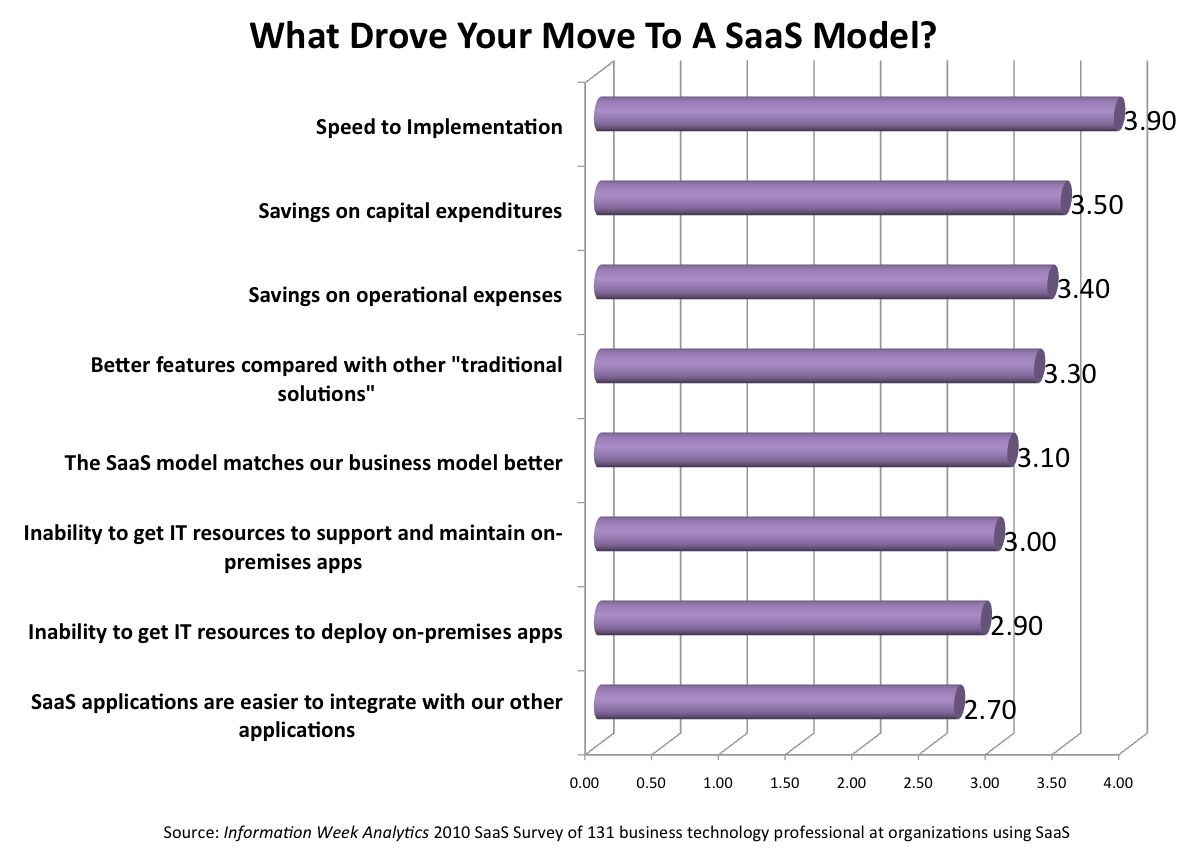Monday's Musings: The Hidden Value In SaaS Deployments

Gains In SaaS Adoption Driven By Speed And Cost Savings...
Preliminary data from Q4 earnings data show continued traction among SaaS solutions. Expect SaaS deployments to gain steam in 2010 as organizations finalize their SaaS apps strategies to take advantage of 7 key benefits:
- Richer user experience - SaaS apps bring Web 2.0 usability to the enterprise world through rich internet applications using Adobe Air, HTML 5, Microsoft Silverlight, and other tools.
- Rapid implementation - SaaS applications focus on configuration and integration, not hard core implementation. Users can be up in weeks, not months.
- Frequent cycles of innovation - At present, most vendors introduce new functionality, enhancements, and bug fixes on frequent refresh cycles. Some vendors provide as frequent as weekly updates, others - seasonal.
- Minimal upgrade hassles - Users focus on minimal testing scenarios and receive updates all at once. In applications with significant regulatory and tax updates, SaaS applications reduce the cost of compliance by as much as 77%.
- Always on deployment - Organizations can expect average up-time levels at 99.95% or higher for most applications. These results often exceed existing on-premise performance.
- Subscription pricing - Subscription pricing reduces the capital burden of common on-premise payment models.
- Scalability - Organizations can add or subtract users as needed without worrying about procuring new hardware and other infrastructure.
Moreover, latest Information Week Analytics survey reaffirms several key benefits of SaaS adoption - time to market and cost savings (see Figure 1).
Figure 1. Information Week Analytics Survey Confirms Trends In Adoption
...Yet, Aggregated Information Provides The Differentiated Value To Clients
Despite the obvious benefits with SaaS deployments, three hidden advantages will emerge with market maturity:
- Benchmarking. SaaS vendors sit on a tremendous treasure trove of data. Participating organizations could opt-in to share secure and masked information for the purposes of business optimization.
- Trending. Organizations could also opt-in to identify larger market trends. Trending information could be used to help organizations with planning.
- Prediction. More sophisticated organizations will take SaaS vendor trending data and design new algorithms to support predictive analytics. The richness and consistency of the data set will improve accuracy.
The Bottom Line For SaaS Vendors - Create Additional Value As An Information Broker
The end game for SaaS vendors may not be a re-creation of the on-premise world in the Cloud. In fact, those vendors with a true multi-tenant SaaS model may turn out to find additional revenue streams as information brokers. Expect demand for premium information-on-demand services to begin with benchmarking and evolve to prediction. For example, imagine the benefits gained by organizations who consume the latest buying behavior data from their CRM vendors. Organizations could turn to HCM vendors for geographical salary or hiring trends. Customers of financial vendors could better predict credit risk factors. A key requirement - customers must trust their SaaS vendor's data ownership and privacy policies before the industry makes this transformation. With acceptance, vendors will have more reasons to move to a SaaS offense.
The Bottom Line For Organizations - Determine Your Data Rights Before You Sign The Contract
Organizations in SaaS deployments will want to preserve the their data rights and minimize their cost structures to consume aggregated information. A few key areas should be considered:
- Data usage. Organizations generally assume that the data belongs to the organization while the software belongs to the SaaS vendor. To be safe, organizations will want to be clear that rights to use data will require an organization's permission. In addition, the disposition of data should be made clear
- Data access. Organizations should expect unhindered access to raw data, queries, and extraction. Access to data should not require additional fees.
- Aggregated data cost. Organizations participating in aggregated data programs should be given preferential treatment not only in cost, but also access to data. The cost of this "stone soup" approach should be factored in pricing.
Your POV
Where are you in your SaaS deployment? Have you thought about these long-term benefits? Looking for assistance with crafting, validating, or reviewing your SaaS Apps Strategy? Do you have a different point of view? Please post or send on to rwang0 at gmail dot com or r at softwareinsider dot org and we’ll keep your anonymity.
Other Useful SaaS Strategy Links
20091222 Tuesday's Tip: 10 Cloud and SaaS Apps Strategies For 2010
20091012 Research Report: Customer Bill of Rights - Software-as-a Service
20090602 Tuesday's Tip: Now's The Time To Consider SaaS Software Escrows
20081028 Tuesday's Tip: SaaS - Integration Advice
20090714 Sandhill.com - R 'Ray' Wang - "Opinion: Moving to a SaaS Offensive"
20070903 Trends: What's all the fuss about True SaaS, OnDemand, Hosting?
20091208 Tuesday's Tip: 2010 Apps Strategies Should Start With Business Value
20091109 Monday's Musings: SaaS, SOA, Integration and How To Make A Peanut Butter And Jelly Sandwich In The Cloud
Copyright © 2010 R Wang and Insider Associates, LLC. All rights reserved.
 R "Ray" Wang
R "Ray" Wang R "Ray" Wang
R "Ray" Wang